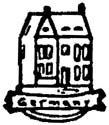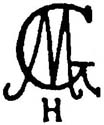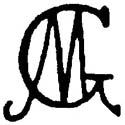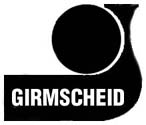 |
 |
 |
 |
 |
by Les Hopper and Frank Loevi
This article is intended as an adjunct to the on-line Matthias Girmscheid Stein Catalog in the Beer Stein Library. Various links provided herein will take the reader directly to examples provided in the catalog. After viewing a catalog example, use the “Back” button on your Internet browser to return to the article.
History
Matthias Girmscheid was born in 1845 to merchant parents and began his working life in the family tradition, opening his own trading firm in 1870 in the town of Höhr (now Höhr-Grenzhausen), at the center of Germany’s principal stoneware production area. In 1871, he married Theresia Gerz, daughter of the potter Philipp Jakob Gerz, which no doubt contributed to his decision to change his career from marketing to production.
Girmscheid’s manufacturing company began it’s life in 1884 and was apparently engaged initially in the manufacture of clay pipes. State records from 1893 list the firm as a pipe factory with ten employees. It is not known precisely when Girmscheid expanded his operation to include the manufacture of beer steins and related stoneware products, but by 1903 the firm was listed as a “stoneware factory” and the employer of forty workers.
In 1920, in what was almost certainly a response to Germany’s difficult post-war economy, Girmscheid merged with the firm of Gilles & Sohn. In 1930, two years following the death of Matthias Girmsched, the composition of the firm changed again. The new firm was called Girmscheid, Michels & Company, and included among its owners: Karl Girmscheid, who had taken over for his father; Simon Gilles, of Gilles & Sohn; and Alfons and Eduard Michels. However, this partnershp was to survive for only one year and, in 1931, the firm of “Matthias Girmscheid” returned to independent operations.
Following the death of Karl Girmscheid in 1950, the company went through a series of ownership changes, but it continues in operation today, enjoying a healthy business focused principally on the manufacture of traditional salt-glazed tableware and decorative items.
With that background, we’ll now turn to a discussion of Girmscheid beer steins, focusing first on physical attributes and recognition.
Stein Characteristics
There are five factory marks currently known to have been used by the Girmscheid factory. However, as is true with the products of many of the early Westerwald factories, steins actually bearing a Girmscheid factory mark are the exception rather than the rule. Of more than 350 steins contained in the on-line Girmscheid catalog as this article is written, less than 10% display one of the known factory marks shown below.
|
|
|
|
|
Little is currently known regarding the usage dates of marks 1 through 3, other than the fact that, where they are found, it will be on “early” (i.e., pre-WWII) steins. In an effort to refine that knowledge with a little empirical analysis, and based on the assumption that mold numbers were likely to have been applied sequentially over time, an attempt was made to establish a relationship between mold numbers and factory marks among catalog examples. Unfortunately, the results were disappointing. Based on our mold number vs. mark analysis, one would have to conclude that all three marks were in use simultaneously.
Marks 4 and 5 are clearly more modern than the first three. However, even though the factory is still operational, it is under relatively new managment with little or no historical knowledge, so exact usage dates for even modern marks cannot be accurately established. However, we know that Mark 4 was in use in the 1960s, and probably beyond, based on a factory catalog from that period that has been widely circulated among Girmscheid collectors (i.e., Katalog F). Exactly when that mark went out of favor is unknown, but Mark 5 is currently in use and has been the mark of choice since at least the early 1990s.
Artist’s (modeler’s) signatures, where they exist, can often be a helpful tool in identifying manufacturers, particularly where an artist is known to have worked for only a single firm. The well-known “GT” of Gustav Thinwiebel, for instance, is an absolutely certain identifying characteristic of early steins made by Marzi & Remy. Unfortunately, while Girmscheid had at least two artists that appear to have been primarily employed by that company and whose signatures appear on a substantial majority of Girmscheid beer steins, recent evidence makes it clear that at least some of their designs were produced by other manufacturers.
Anton Kilian (Karl) Beuler
The first and clearly most prolific of the two was Kilian Beuler, with his “KB” signature appearing on more than 55% of currently cataloged Girmscheid steins. As might be expected, the signatures vary somewhat from stein to stein, but conform generally to the three configurations shown below.
|
|
|
Beuler was born in Höhr in 1865 and began his career with Girmscheid around 1890, where it is believed he was employed for approximately the next 25 years. However, Bueler is also known to have moonlighted as a freelance artist, selling his designs to other manufacturers as well. In addition to his substantial output for Girmscheid, Beuler’s “KB” mark has also been seen on steins produced by J.L. Knoedgen, Gilles & Sohn, A.J. Thewalt, et al.
Beuler’s work is characterized principally by bold deep relief (although there are also a number of known “etched” pieces bearing his signature), outstanding ceramic representation of wood grain and, perhaps most importantly, the frequent use of figural ceramic lids. His “KB” signature can be found either incised into the mold or in relief, and sometimes simply painted under the glaze. For some examples of Bueler at his best, see Girmscheid mold Nos. 759, 1226, 1264 and 1273.
While Bueler’s initials on a stein do not necessarily mean that it was produced by Girmscheid, it makes that conclusion far more likely than not, particularly when combined with other Girmscheid indicators discussed later in this article.
Unknown Artist “GK”
Although the name of the modeler who signed his work “GK” has yet to be discovered, his signature appears, in variations of the three configurations shown below, on almost 15% of currently cataloged Girmscheid steins.
|
|
|
Little or nothing is really known about “GK” other than the fact that, based on an analysis of mold numbers, he was evidently a contemporary of Beuler at Girmscheid. The striking similarities of the styles of “GK” and “KB” would appear to indicate a teacher/pupil relationship, but even which one might have been the teacher is uncertain. There are few discernable differences between GK’s work and Beuler’s, as may be seen by comparing some examples with those of Beuler suggested above. See, for instance, Girmscheid mold Nos. 155, 188, 1032 and (X18).
As with Beuler, evidence exists indicating that “GK” also served as a modeler for other Westerwald firms. Consequently, although it can be helpful, the “GK” signature cannot be relied upon exclusively as a Girmscheid indicator.
Others
Several other artist’s marks have been seen on Grimscheid steins, but they appear only infrequently and are of little value in identifying Girmscheid steins. They are shown and discussed below solely for the sake of completeness.
|
|
|
|
At this point in time, none of the three different sets of initials (AD, AS & TW) can be clearly associated with a particular individual. There has been some speculation that “AD” represents an Adolph Dekker, who is presumed to be the brother or Rudy Dekker, a modeler known to have been employed by several Westerwald firms. To date, the catalog lists only a single example bearing the “AD” signature. It’s an unnumbered stein depicting Bardolf and Falstaff, with a figural lid known to have been designed by Kilian Beuhler.
No information, or even speculation, has so far been put forth regarding the identity of “AS” but, here again, his work is limited to a single design (produced in two varieties: Nos. 963 and 964). Were it not for the factory marks on these steins, one might not even associate them with Girmscheid.
The initials “TW” show up on a small number of known Girmscheid steins which generally display characteristics that strongly suggest the influence of Kilian Bueler. The “TW” signed steins numbered 1198 and 1249, for example, both have figural lids designed by Bueler. It has been suggested that “TW” might stand for “Theodore Weisiler,” a Nuremberg dealer, and was applied to another’s work in recognition of his role as sole distributor. We suspect that this is not the case, but at this point have no evidence one way or the other. However, we consider it far more likely that the initials represent a modeler who spent only a short time in the employ of Girmscheid operating under the tutelage of Kilian Beuler.
Before leaving this topic, it should be noted that the modeler Rudy Dekker, mentioned above, has been thought by some to have been employed by Girmscheid at some point in his career, and that a substantial number of steins bearing the initials “RD” were products of the Girmscheid factory. However, recent research clearly indicates that most, if not all, of the known “RD” steins were actually produced for either Reinhold Hanke or S.P. Gerz. The possibility still remains that Rudy Dekker spent time working for Girmscheid, but so far not a single “RD” stein has surfaced that also bears a Girmscheid mark, leading us to believe that the possibility is slim, at best.
Another excellent way to spot a Girmscheid stein is by looking at the handle. While Girmscheid, like most manufacturers, used of a fairly wide variety of handle designs, more than half of all Girmscheid steins employ a handle with a “twisted vine” design like those shown below. However, one needs to be careful when relying on this characteristic to identify a Girmscheid stein, in that nearly every Westerwald manufacturers made at least occasional use of similar handle designs. Nonetheless, where a handle has a twisted vine design, the first factory that should come to mind is Girmscheid.
|
|
|
|
|
|
Of course, thinking that a stein might be made by Girmscheid isn’t quite the same as knowing it for sure, so if the handle design being sought isn’t among those pictured above, readers would be well advised to access the Westerwald Beer Stein Handle Gallery, which provides a more complete look at twisted vine handles on Girmscheid steins, as well as those found on steins produced by other manufactures.
Pewter
As was true for most Westerwald stein manufacturers in the late 19th and early 20th centuries, Girmscheid steins could generally be purchased with any one of a variety of lids. Available pewter lids ranged from the fairly commonplace thin steeple type (example) to the more elaborate and substantial (example). The Girmscheid factory, as might be expected, didn’t make its own pewter lids, so what is found on Girmscheid steins is typical for the Westerwald area and era of manufacture. Needless to say, none of these lids are likely to provide much help in identifying Girmscheid as a stein’s manufacturer and, unfortunately, pewter lids are found on more than three-quarters of all Girmscheid steins.
Figural
In general, the steins most prized by Girmscheid collectors are those with figural ceramic lids. Not counting castle towers and a few other “character” steins with ceramic lids (like tower roofs) that are matched to the body of the stein, Girmscheid manufactured about twenty-five different figural lids. These could be applied to relief steins, at the customer’s option, in place of pewter lids. It is unclear whether or not Girmscheid made that option available for all relief steins, but it would appear likely that the option of a figural lid was the rule rather than the exception.
Among those offered, the “barmaid” and “shepherd” lids run about neck and neck for the most frequently seen, as they were gererally applied to steins depicting either tavern scenes or scenes from day-to-day tyrolean life, easily the most two popular subjects for decorating beer steins of the period. A few of the other more popular figural lids may be seen in some of the examples cited previously. Note, however, that not all figural lids were destined for multiple applications. In some instances, figural lids appear to have been designed for a particular stein. For instance, this was true more often than not with sport-themed steins, as exemplified by the tennis balls inlay topping No. 1226, or the bowling ball on No. 1266.
A final fact worth noting is that some of Grimscheid’s figural lids can be found marked with Kilian Bueler’s “KB” signature, thereby helping to narrow substantially any question as to where the stein was manufactured.
Etched
As was true with most manufacturers of its day, when it came to the company’s “etched” steins, Girmsched provided the option of a matching etched lid, many of which can be seen throughout the on-line catalog. However, where the etched lids of most companies consisted of a ceramic inlay in a pewter ring, Girmscheid offered a unique alternative. Most or all of Girmscheid’s ceramic lids could be purchased in either an inlaid version or a version made completely of ceramic material with a silver ring painted around the perimeter to simulate pewter. Here again, the fully ceramic lids were clearly produced with cost in mind and were far more susceptable to breakage than the lids with pewter rings. Where they have survived, however, they appear to be unique to only two companies — Girmscheid and Rosskopf & Gerz, with Girmscheid responsible for a substantial majority of the known examples.
Shown below are a pair of etched lids. The one on the left has a pewter ring and the one on the right does not. Note the chipped front edge on the lid on the right.
|
|
D.R.G.M. Marking
 |
“Old” vs. “New”
By general agreement among beer stein collectors, the line of demarcation between “old” and “new” steins is currently set at World War II. Anything made after WWII is considered too recent to warrant serious attention from collectors of “old” steins. As WWII fades further and further into the past, this dividing line tends to make less and less sense, but in the study of Girmscheid steins it still provides a useful reference point.
There is currently no clear understanding of when particular Girmscheid steins were first produced, except for the fact that we know that Kilian Bueler (“KB”) died in 1928, so that any steins bearing his initials must have been created prior to that time. Our next real insight as to the dating of Girmscheid steins is provided by Girmscheid Katalog F, mentioned above in our discussion on dating factory marks. Although Katalog F is not dated, various clues provided by its content make it reasonably certain that its original issue date is circa 1960.
The content of the catalog is relatively disappointing from a collector’s standpoint, in that it consists principally of reproductions of Girmscheid’s earlier (i.e., pre-WWII) steins, but without the figural lids, or steins that parrot the work of an earlier period, neither of which are of much interest to collectors. That being the case, no attempt has been made to include these steins in the on-line Girmscheid catalog. However, where we have specific knowledge of a post-WWII reproduction bearing the same mold number as an earlier stein, that information has been provided. See, for example No. 1032.
With that said, it should also be pointed out that Katalog F contains a number of character (figural) steins that appear to have been developed from whole cloth in the post-WWII period and that, in our opinion, are clearly worth a second look from collectors. These have been included in the on-line catalog, along with several others we’ve discovered that are not pictured in Katalog F. See, for example, Nos. 101, 834 and 1195.
There has been some speculation that the post-WWII Girmscheid character steins were also reproductions of earlier pieces, but so far there is little evidence to support that contention. One of the steins — No. 828 — has a clear antecedent but, to date, earlier versions of the others have not been seen.
Assuming that we are correct, and that most or all of the post-WWII character steins are not simply reproductions, these will be among the collectable antiques of tomorrow. With secondary market prices generally ranging under fifty dollars, they provide an excellent starting point for the young collector on a budget.
Some Closing Thoughts
Matthias Girmscheid, like most of his contemporaries, produced a wide range of beer steins, ranging from low-end souvenier steins to far more elaborate pieces well suited for display in even the most sophisticated collection. Within that range, there is surely something to please almost any collector.
Perhaps more than some of their fellow steinmakers, Girmscheid (or his two principal modelers) seemed to be highly attuned to local legend and folklore. Among the more pleasing of Girmscheid’s offerings were the steins based on various legends of the Rhine (see, for example, Nos. 163 and 806). Also candidates for inclusion in top drawer collections are some of the full-color relief pieces topped with Girmschied’s unique figural lids. While these steins may have been somewhat impractical as drinking vessels, they display beautifully.
On a final note, it is our hope that the discussion above makes it clear that there is still much to be learned. Over time we hope to continue expanding both the catalog and the available knowledge about Girmscheid, but can do so only with your help. If you have the ability to contribute to this on-going project, we’d love to hear from you.
__________
© 2003-2016 Beer Stein Library — All rights reserved.